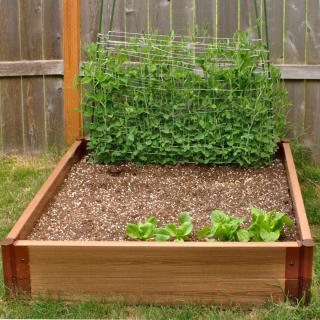

Be it for herbs, greens or tomato, a square-foot vegetable patch works best when a few simple rules are followed.
Read also:
Square-foot veggie garden beds are often constructed with wood. It’s an interesting material for raised garden beds, and indeed there is a whole range of options: pallet wood, joined wood, plywood, wood slabs, construction wood, recycled wood, woven willow reeds… and even ready-to-assemble kits. Varnish the wood or apply an environmentally-friendly paint on the outside, and line the inside with a watertight tarp.
For more permanent structures, go for one of these materials: stone (natural stone, cement, bricks, upended terrace tiles…), metal (line the inside of these with an insulator) and plastic.

To go about this 3-layer soil mix:
To extend the growing season, and thus increase productivity, you can assemble a frame atop your square-foot bed on which a cover is fastened. This might be a plastic cover or one with window panes, the goal is to turn the square-foot patch into a miniature greenhouse. Moisture and warmth will increase.
Avoid glass which is prone to breaking, prefer a film of wire-reinforced plastic or polycarbonate. You can also simply use greenhouse plastic or winterizing materials. Remember to ventilate the bed from time to time to keep the spot from getting too hot and too moist: this might trigger disease.
Snails and slugs can easily climb up vertical surfaces. To avoid having these pests climb up into your square-foot vegetable bed, run a swath of copper tape around the outside of it.
And if you raise your square-foot bed higher off the ground with a few stone tiles, bricks or even simply a sheet of galvanized iron, make sure you bend a metallic rim inwards and downwards, shares author Folko Kullmann.
Directly in the vegetable patch, you can sprinkle organic anti-slug pellets prepared from iron phosphate to keep snail eggs from hatching.
You must water regularly and sufficiently, but without turning everything soggy. As soon as the first cooler nights arrive in Fall, a sheet of winterizing fleece will be very effective at protecting your square-foot bed. After the harvest, when you’ve pulled out the crops, sow green manure (rapeseed or alfalfa). It’ll quickly sprout and that way the soil surface won’t stay bare during winter.
A few years later you can replace the soil in the raised bed at the beginning of Spring.
Folko Kullmann wrote Square Foot Gardening, which is replete with information on how to set up and manage a square foot vegetable patch.
Claire Lelong-Lehoang